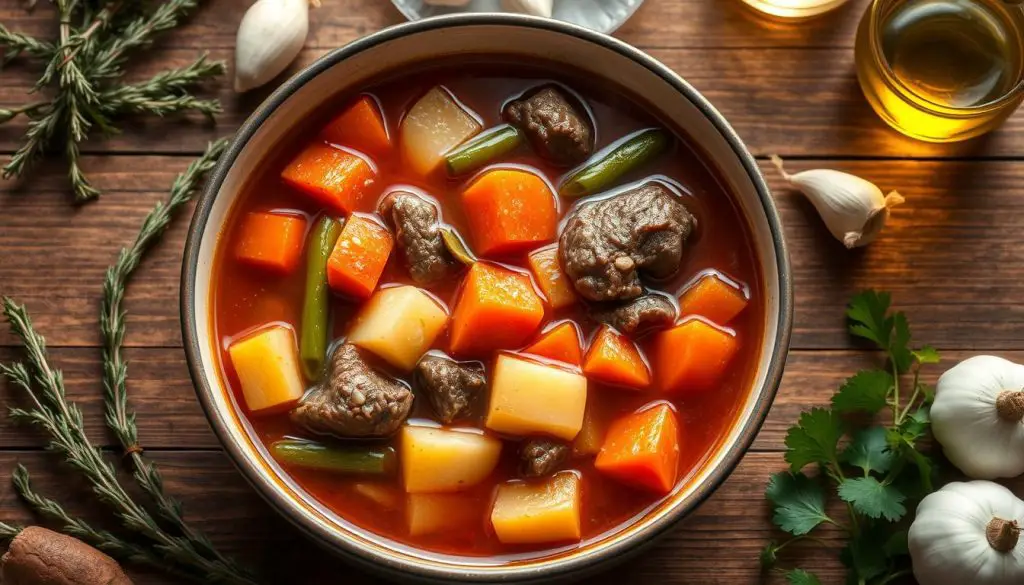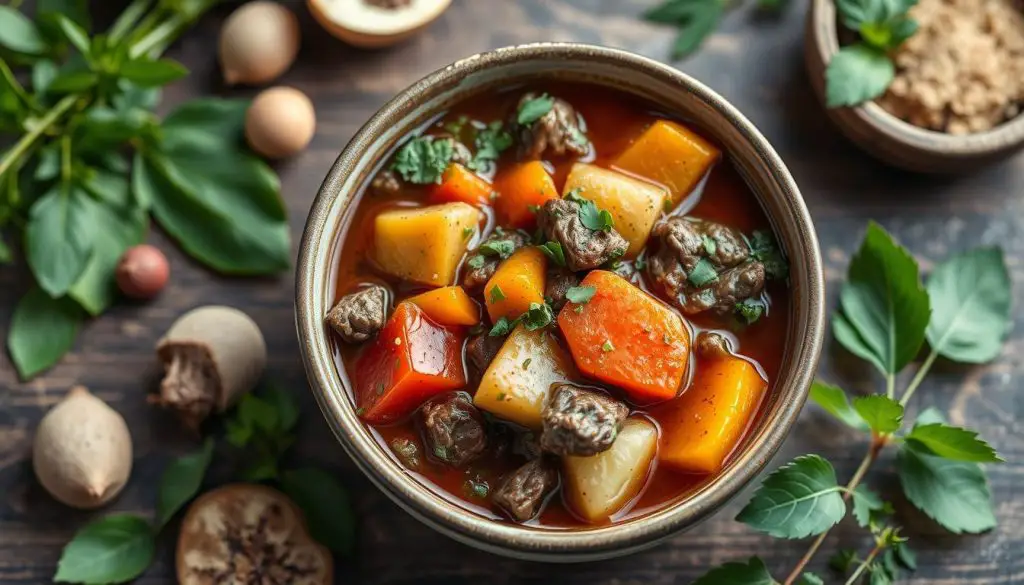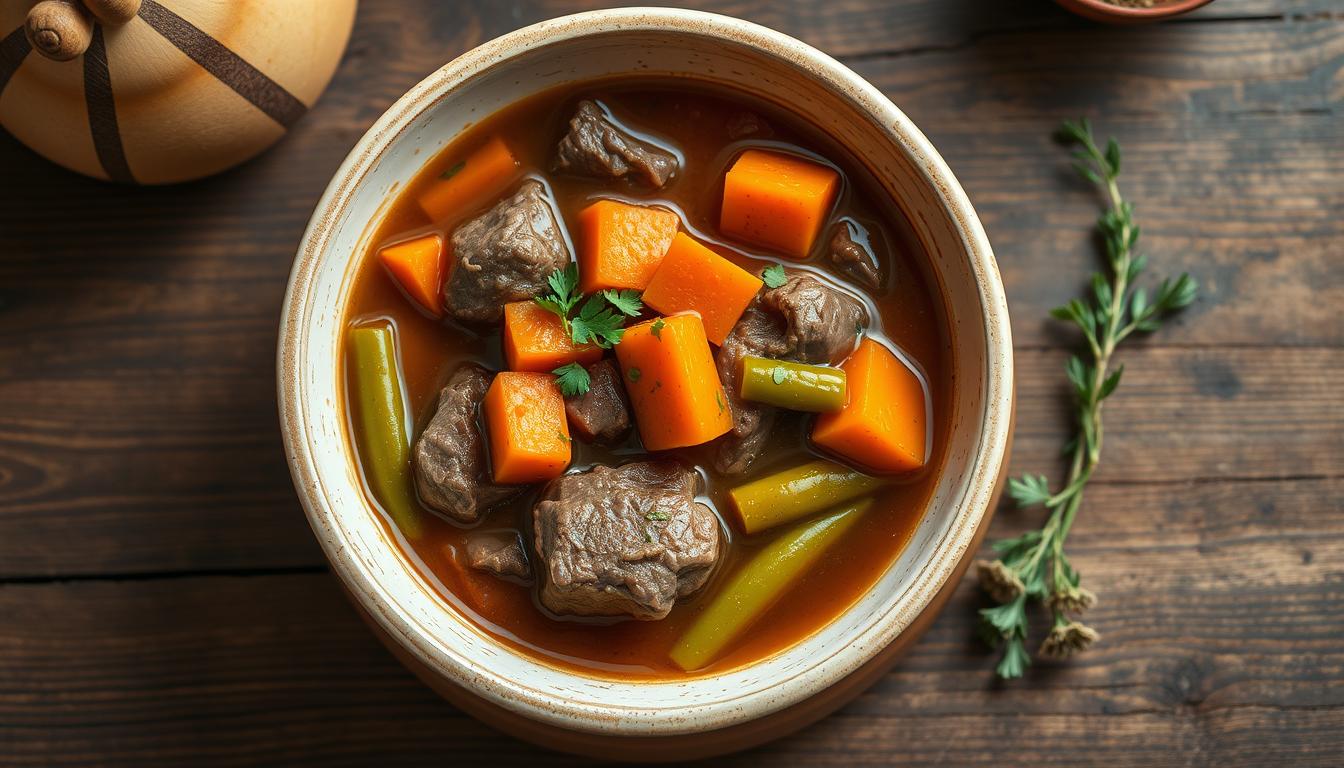Do you deal with chronic pain, fatigue, and digestive problems? You’re not alone. Over 10 million Americans live with fibromyalgia. There’s a simple solution in your kitchen.
Our low FODMAP beef stew is a comforting meal for fibromyalgia symptoms. It has lean beef, low FODMAP veggies, and anti-inflammatory spices. These ingredients help reduce inflammation and support your digestive health.
A study found that a low FODMAP diet helped fibromyalgia patients. They saw a 30% drop in pain and a 20% better quality of life. This stew could do the same for you.
What is a Low FODMAP Diet?
The low-FODMAP diet removes short-chain carbs called FODMAPs. These carbs can cause bloating, gas, and pain in the belly. By avoiding these foods, people can manage their digestive problems.
Removing Fermentable Carbohydrates
This diet cuts down on carbs that can make digestion worse. It means less of:
- Oligosaccharides (in wheat, onions, garlic, and legumes)
- Disaccharides (like lactose in milk)
- Monosaccharides (fructose in fruits and honey)
- Polyols (in sweeteners like sorbitol and xylitol)
By eating less of these carbs, the diet can ease digestive issues and improve gut health.
Studies have proven the low FODMAP diet works for IBS and other digestive problems. It can also help those with fibromyalgia, a condition often linked to IBS.
Benefits of a Low FODMAP Diet for Fibromyalgia
Research shows that a low FODMAP diet can help those with fibromyalgia. It removes foods that cause stomach problems. This can reduce bloating, gas, and stomach pain.
It also has anti-inflammatory effects. This can lessen chronic pain and inflammation linked to fibromyalgia.
Studies suggest that diet can help manage fibromyalgia symptoms. They looked at different diets, including low FODMAP, hypocaloric, and vegetarian/raw vegetarian diets. The results showed improvements in pain, function, quality of life, and emotional health.
For instance, a four-week low FODMAP diet cut symptoms by 50%. A hypocaloric diet improved quality of life, sleep, anxiety, and depression. Vegetarian and raw vegetarian diets also showed benefits in Fibromyalgia Impact Questionnaire Revised (FIQR) scores and emotional health.
Some foods, like salmon, spinach, blueberries, and olive oil, are good for fibromyalgia. Avoid processed foods, refined carbs, and some vegetable oils. They can make symptoms worse.
By following a low FODMAP diet and eating anti-inflammatory foods, fibromyalgia patients can manage their condition better. It’s important for researchers, healthcare professionals, and patients to work together. This will help find more ways to use diet to improve fibromyalgia management.
Low FODMAP Beef Stew Ingredients
This low FODMAP beef stew is perfect for those with fibromyalgia. It has lean beef for protein, and veggies like carrots, parsnips, and spinach that are low in FODMAPs. It also has spices like ginger, turmeric, and rosemary to help fight inflammation and pain.
Key Ingredients
- Lean beef – A excellent source of protein to support muscle health and recovery.
- Carrots – A low FODMAP vegetable that is rich in fiber, vitamins, and minerals.
- Parsnips – Another low FODMAP vegetable that provides anti-inflammatory benefits.
- Spinach – A nutrient-dense green that is low in FODMAPs and high in antioxidants.
- Ginger – An anti-inflammatory spice that can help alleviate fibromyalgia-related pain.
- Turmeric – A potent antioxidant with powerful anti-inflammatory properties.
- Rosemary – An herb rich in compounds that may reduce inflammation and improve brain function.
This stew is packed with fibromyalgia-friendly foods and anti-inflammatory spices. It’s made to nourish and support those with fibromyalgia.
Low FODMAP Vegetable Options
Managing fibromyalgia can be easier with a low FODMAP diet. This diet helps reduce digestive discomfort and supports gut health. There are many low FODMAP vegetables you can add to your diet.
Some great low FODMAP vegetable choices include:
- Carrots
- Parsnips
- Spinach
- Bok choy
- Zucchini
- The green parts of green onions
These low FODMAP vegetables are easy on your stomach. They also provide important nutrients to help manage fibromyalgia symptoms. Avoid high FODMAP vegetables like onions, garlic, and mushrooms. They can make digestive problems worse.
| Vegetable | FODMAP Content |
|---|---|
| Carrots | Low |
| Parsnips | Low |
| Spinach | Low |
| Bok choy | Low |
| Zucchini | Low |
| Green onion (green parts only) | Low |
| Onions | High |
| Garlic | High |
| Mushrooms | High |
Adding these gut-friendly foods to your diet can help your overall health. It may also reduce some fibromyalgia symptoms.

Preparing the Low FODMAP Beef Stew
Making a tasty low FODMAP beef stew is easy, even for beginners. It’s great for those with fibromyalgia. The stew has tender beef, low FODMAP veggies, and spices that help your gut feel good.
Step-by-Step Instructions
- First, get all your ingredients ready. You’ll need lean beef, low FODMAP veggies like carrots and parsnips, and spices like thyme and ginger.
- Heat a big pot or slow cooker over medium-high. Brown the beef until it’s seared on all sides. This makes the stew taste better.
- Put the veggies, herbs, spices, and broth in the pot. Make sure everything is covered and let it simmer gently.
- If you’re using a slow cooker, cook on low for 6-8 hours. For stovetop, cook on low for 45-60 minutes until the beef is tender.
- When it’s done, check the flavor and add more if needed. Serve hot, topped with fresh herbs or low FODMAP cheese.
Follow these steps for a delicious, gut-friendly stew. It’s perfect for fibromyalgia management. The prep is easy, and the ingredients are nourishing, making it a great choice for a comforting meal.
Low FODMAP beef stew for fibromyalgia
If you have fibromyalgia, finding meals that help your body and manage symptoms is hard. But, this low FODMAP beef stew is made just for you. It’s designed to ease digestive issues and inflammation linked to this chronic condition.
This stew uses ingredients low in FODMAPs. This helps with bloating, gas, and stomach pain. The ingredients also have anti-inflammatory properties. This can help reduce pain and inflammation, aiding in your fibromyalgia management.
This stew is not only good for fibromyalgia but also great for your gut health. It’s a comforting and nourishing meal. Enjoy it as part of your journey to better manage your fibromyalgia symptoms.
Nutrient-Dense Meal for Fibromyalgia Relief
The low FODMAP beef stew you’ve made is not only good for your gut. It’s also packed with nutrients that help with fibromyalgia. The lean beef gives you quality protein for muscle health. The veggies add essential nutrients to fight inflammation and manage fibromyalgia symptoms.
Adding this stew to your diet can boost your health and ease symptoms. Let’s see how it can help you manage fibromyalgia better.
Nutrient-Rich Ingredients for Fibromyalgia Relief
- Lean beef: Provides high-quality protein to support muscle health and recovery.
- Low FODMAP vegetables: Offer a variety of vitamins, minerals, and antioxidants to reduce inflammation.
- Anti-inflammatory spices: Such as turmeric, ginger, and garlic, which can help manage pain and other symptoms.
These ingredients combine to make a nutrient-dense meal. It helps ease fibromyalgia symptoms like chronic pain, fatigue, and brain fog.
| Nutrient | Benefit for Fibromyalgia |
|---|---|
| Protein | Supports muscle health and recovery, important for managing fibromyalgia-related muscle pain and weakness. |
| Vitamins and Minerals | Help reduce inflammation, boost energy levels, and support overall well-being. |
| Antioxidants | Combat oxidative stress and reduce inflammation, which can help manage fibromyalgia symptoms. |
Enjoying this tasty and nutrient-dense beef stew gives your body what it needs. It helps manage fibromyalgia symptoms and improves your life quality.
Gut-Friendly Recipes for Fibromyalgia
Keeping the gut healthy is key for those with fibromyalgia. This low FODMAP beef stew is a great example of gut-friendly recipes for fibromyalgia management. These meals are easy to digest and packed with anti-inflammatory ingredients. They help support digestive health and may ease symptoms.
A low FODMAP diet helps reduce stomach discomfort for fibromyalgia patients. It cuts out fermentable carbs that cause bloating and pain. This diet is tailored to meet their digestive needs, making meals that are both nourishing and symptom-friendly.
There are many more gut-friendly recipes good for fibromyalgia. Some include:
- Grilled salmon with roasted sweet potatoes and asparagus
- Quinoa and vegetable stir-fry with ginger and turmeric
- Homemade chicken broth with low FODMAP vegetables
- Baked cod with roasted zucchini and cherry tomatoes
Adding these meals to their diet can help fibromyalgia patients feel better. It’s all about choosing foods that are easy on the stomach but also full of nutrients. This way, they can manage their condition better.

Anti-Inflammatory Diet and Fibromyalgia
Research shows that an anti-inflammatory diet might help those with fibromyalgia. This diet fights chronic inflammation, a big problem for fibromyalgia patients. It helps with muscle pain, fatigue, and other symptoms.
By eating foods like herbs and spices in this low FODMAP beef stew, fibromyalgia patients might see less inflammation. This could help them manage their pain better.
The Role of an Anti-Inflammatory Diet
An anti-inflammatory diet is all about eating whole, nutrient-rich foods. These foods help lower inflammation and pain. It’s about adding more plant-based, anti-inflammatory ingredients and cutting out processed foods and unhealthy fats.
- Cardio-metabolic diseases, arthritis, and autoimmune conditions are all linked to chronic inflammation.
- An anti-inflammatory eating plan suggests aiming for meals that are 80% anti-inflammatory, with the goal of making them 90-100% anti-inflammatory.
- Whole plant foods contain phytochemicals with anti-inflammatory and antioxidant properties, supporting better immune and gut health.
By following an anti-inflammatory diet, fibromyalgia patients can manage chronic inflammation better. This can help reduce their pain management needs.
Symptom Management with Whole Food Ingredients
Managing fibromyalgia symptoms can be helped by using whole food ingredients. This low FODMAP beef stew is a great example. It uses lean protein, veggies, and spices to help those with fibromyalgia.
Whole foods are better than processed or artificial stuff for fibromyalgia. They help with pain, fatigue, and digestion. Eating foods that are rich in nutrients can boost your health without needing drugs.
Here are some benefits of using whole foods for fibromyalgia:
- Reduced inflammation: Foods like leafy greens, fatty fish, and turmeric can reduce pain and swelling.
- Improved digestion: Foods high in fiber can help your gut and prevent bloating and constipation.
- Enhanced energy and vitality: Whole foods give you the vitamins and minerals you need to fight fatigue and brain fog.
Adding this low FODMAP beef stew and other whole food recipes to your diet can help manage fibromyalgia symptoms naturally. Check out these resources to learn more about whole foods and your health.

Gluten-Free Cooking for Chronic Pain
For those with fibromyalgia, changing what they eat can help a lot. This stew is not only easy on the stomach but also free from gluten. This makes it great for people with gluten sensitivities or intolerances.
By avoiding foods that might cause pain and choosing whole foods, people with fibromyalgia can feel better. Gluten-free cooking helps by removing a common cause of inflammation. This can make their pain less severe.
About 4 million adults in the U.S. live with fibromyalgia. Studies show that certain diets, like low-FODMAP and gluten-free, can help. By cooking gluten-free, those with fibromyalgia can take a big step towards controlling their pain.
The Benefits of Gluten-Free Cooking for Fibromyalgia
- Reduces inflammation and joint pain
- Improves gut health and digestion
- Boosts energy levels and reduces fatigue
- Supports overall wellness and quality of life
Using gluten-free, anti-inflammatory foods in your meals can help fight fibromyalgia symptoms. This stew is a tasty way to get the nutrients your body needs to feel its best.
Managing fibromyalgia is a personal journey. What works for one person might not work for another. It’s key to work with your healthcare team to find the right diet for you. With the right recipes and a focus on nourishing your body, you can manage your pain and improve your health.
Digestive Health and Fibromyalgia
Research shows a strong link between gut health and fibromyalgia symptoms. People with fibromyalgia often face digestive problems like bloating and pain. These issues are common in those with this chronic condition.
The Gut-Brain Connection in Fibromyalgia
Following a low FODMAP diet can help. This diet, like the one in this beef stew recipe, may improve digestion. It could also reduce some of the digestive symptoms that come with fibromyalgia.
Fibromyalgia affects about 4 million adults in the U.S. Low-calorie and vegetarian diets, rich in anti-inflammatory foods, may help manage symptoms. Low FODMAP diets, which avoid certain carbs, are also anti-inflammatory and good for fibromyalgia sufferers.
Adding anti-inflammatory foods to their diet can help those with fibromyalgia. This can reduce chronic inflammation and ease symptoms. The recipes in this article offer low FODMAP, vegetarian, and low-calorie options. They aim to meet the dietary needs of those managing fibromyalgia.

Chronic Pain Management Through Diet
While there’s no cure for fibromyalgia, you can manage your chronic pain through diet. The low FODMAP beef stew in this article is a great example. It shows how a gut-friendly meal can help in managing fibromyalgia.
By eating anti-inflammatory, nutrient-rich foods, you can boost your health. Foods like peas, nuts, berries, bananas, garlic, lentils, and carrots are full of good stuff. They can help ease fibromyalgia symptoms.
Studies have found that plant-based and vegetarian diets are good for health. They can lower blood pressure, improve blood sugar, and reduce inflammation. A holistic diet can be a key part of managing chronic pain and improving your overall health.
Source Links
- https://mthfrsupport.com.au/2021/10/low-fodmap-beef-curry-instant-pot-paleo-aip-keto/
- https://nourishingmeals.com/
- https://drruscio.com/ibs-diet/
- https://revistas.proeditio.com/jonnpr/article/view/4274/PDF4274
- https://www.healthline.com/health/diverticulitis-diet-list-of-foods-to-avoid
- https://www.healthline.com/nutrition/fibromyalgia-diet-recipes
- https://www.paincation.com/seeking-relief-from-fibromyalgia-through-diet-a-hopeful-path-in-a-sea-of-doubts-rss/
- https://www.healthyfood.com/advice/food-fodmaps-and-ibs-what-to-eat-and-what-to-avoid/
- https://nourishingmeals.com/diet/basic-elimination-diet
- https://thyroidpharmacist.com/articles/low-fodmap-diet-sibo-ibs-hashimotos/
- https://www.healthline.com/health/22-ibs-friendly-recipes
- https://tipsforme.wordpress.com/2023/02/20/keto-and-low-fodmap-that-could-be-a-high-tension-competitive-tv-show/
- https://www.healthline.com/health/crohns-disease/recipes
- https://betterme.world/articles/autoimmune-diet-plan/
- https://www.marigoldfoods.com/foods-that-help-fight-pain/
- https://nourishingmeals.com/diet/low-fodmap
- https://www.verywellhealth.com/leaky-gut-diet-4773680
- https://www.healthrising.org/blog/2015/01/06/beating-bloat-best-diet-irritable-bowel-syndrome/
- https://desireerd.com/anti-inflammatory-diet/
- https://www.linkedin.com/pulse/indian-diet-plan-fibromyalgia-management-roshni-sanghvi-q1ugc
- https://arizonapain.com/best-anti-inflammatory-cookbooks/
- https://www.mindsethealth.com/matter/low-fodmap-diet
- https://theceliacmd.com/diets-for-leaky-gut-which-is-best-2/
- https://universityhealthnews.com/daily/pain/fibromyalgia-diet-may-help-control-pain/
- https://www.healthline.com/health/crohns-disease/foods-manage-helen-marley
- https://www.ncbi.nlm.nih.gov/pmc/articles/PMC10056340/
